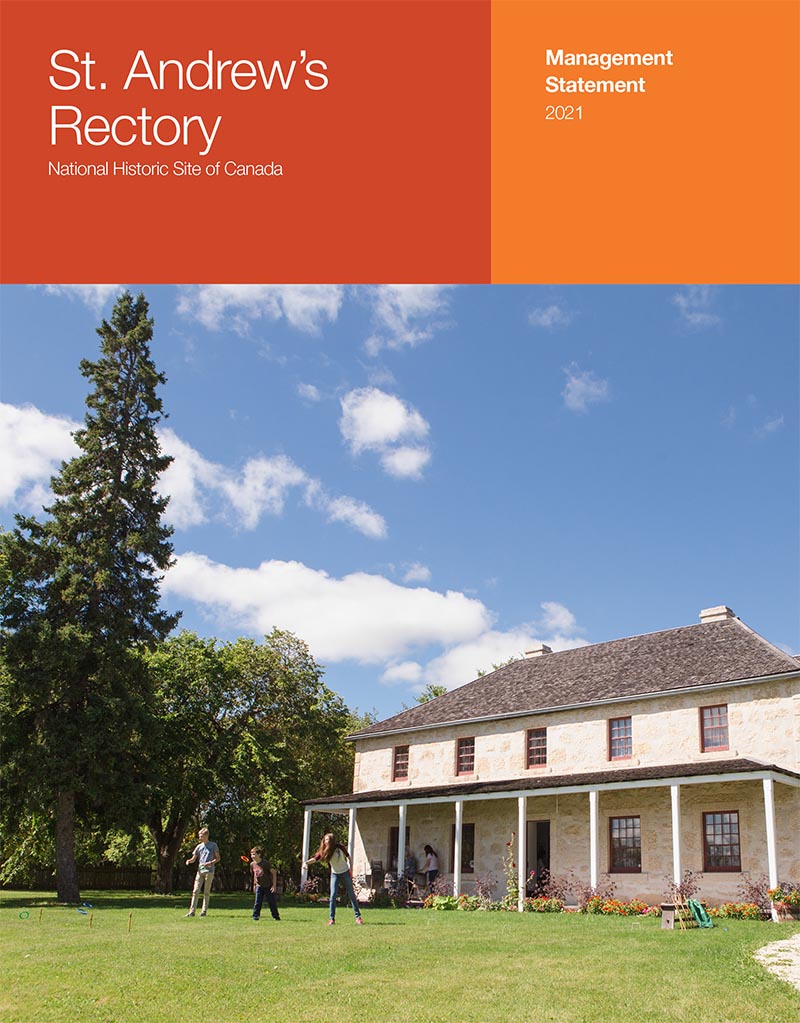St. Andrew’s Rectory National Historic Site of Canada Management Statement, 2021
St. Andrew's Rectory National Historic Site

Table of contents
Maps and figure
Title: St. Andrew’s Rectory National Historic Site of Canada Management Statement, 2021
Organization: Parks Canada Agency
Note to readers
The health and safety of visitors, employees and all Canadians are of the utmost importance. Parks Canada is following the advice and guidance of public health experts to limit the spread of COVID-19 while allowing Canadians to experience Canada’s natural and cultural heritage.
Parks Canada acknowledges that the COVID-19 pandemic may have unforeseeable impacts on the St. Andrew’s Rectory National Historic Site of Canada Management Statement.
Foreword

Minister of Environment and Climate Change and Minister responsible for Parks Canada
From coast to coast to coast, national historic sites, national parks and national marine conservation areas are a source of shared pride for Canadians. They reflect Canada’s natural and cultural heritage and tell stories of who we are, including the historic and contemporary contributions of Indigenous peoples.
These cherished places are a priority for the Government of Canada. We are committed to protecting natural and cultural heritage, expanding the system of protected places, and contributing to the recovery of species at risk.
At the same time, we continue to offer new and innovative visitor and outreach programs and activities to ensure that more Canadians can experience these iconic destinations and learn about history, culture and the environment.
In collaboration with Indigenous communities and key partners, Parks Canada conserves and protects national historic sites and national parks; enables people to discover and connect with history and nature; and helps sustain the economic value of these places for local and regional communities.
This new management plan for St. Andrew’s Rectory National Historic Site of Canada supports this vision.
Management plans are developed by a dedicated team at Parks Canada through extensive consultation and input from Indigenous partners, other partners and stakeholders, local communities, as well as visitors past and present. I would like to thank everyone who contributed to this plan for their commitment and spirit of cooperation.
As the Minister responsible for Parks Canada, I applaud this collaborative effort and I am pleased to approve the St. Andrew’s Rectory National Historic Site of Canada Management Plan.
Recommendations
Recommended by:
Ron Hallman
President & Chief Executive Officer
Parks Canada
Andrew Campbell
Senior Vice-President, Operations Directorate
Parks Canada
Terrie Dionne
Superintendent, Manitoba Field Unit
Parks Canada
Introduction
Parks Canada manages one of the finest and most extensive systems of protected natural and historic areas in the world. The Agency’s mandate is to protect and present these places for the benefit and enjoyment of current and future generations. This management statement outlines Parks Canada’s management approach and objectives for St. Andrew’s Rectory National Historic Site of Canada.
St. Andrew’s Rectory National Historic Site of Canada lies 25 km north of Winnipeg, Manitoba in the Rural Municipality of St. Andrews. The Rectory was once part of a larger network of buildings and facilities serving a community of Hudson’s Bay Company personnel and local residents. The prominence and social status of the Church Mission Society in Rupert’s Land are reflected in this two-storey stone rectory. Completed in 1854, the Rectory was larger and grander than a typical home in the Red River settlement.
St. Andrew’s Rectory was designated of national historic importance in 1962 as an example of mid 19th century Red River architecture. This style, also known as a Hudson’s Bay style of architecture, adapted Scottish building techniques for use on the Canadian frontier and added local styles like the French-Canadian-style wooden verandah.
The site was acquired by the Government of Canada in 1976. Soon after, the Rectory was determined to be in poor structural condition. Although the building was largely dismantled and rebuilt in the 1980s, it remains true to the style and features of the original.
Management approach
St. Andrew’s Rectory National Historic Site is currently operated by the St. Andrews Heritage Centre Committee, a group of volunteers, who are supported by the offices of the Rural Municipality (RM) of St. Andrews. In 2013, Parks Canada and the RM of St. Andrews negotiated a License of Occupation Agreement for the site that is in effect until 2033. The goal of the Heritage Centre is to showcase the history of the St. Andrews area and the Rectory, and this is achieved through the creation and delivery of organized tours, interpretive programming, special events and local workshops. Over the past years, the Heritage Centre has expanded its offer to the public at the site from a spring-summer seasonal operation, to now offering programming and events throughout the year.
Parks Canada’s Manitoba Field Unit Superintendent provides oversight for the site, which is run by a third party. Parks Canada is responsible for major infrastructure investments and maintenance. Parks Canada assists the Heritage Centre staff when possible from its offices in Winnipeg and at Lower Fort Garry National Historic Site.
Management objectives
Building Relationships with Aboriginal Peoples
Parks Canada respects Aboriginal rights and land claim agreements and building mutually beneficial relationships with Indigenous communities is a priority for the Agency. Indigenous communities associated with the site are engaged to ensure that their voices, perspectives and histories are respectfully incorporated into the interpretation and protection of the site.
Cultural Resource Conservation
Parks Canada protects cultural resources at St. Andrew’s Rectory in accordance with its Cultural Resource Management Policy and the Standards and Guidelines for the Conservation of Historic Places in Canada. Preservation of the site is achieved through active cultural resource conservation and strategic asset investments. Parks Canada preserves the elements that define the character of the national historic site and give meaning to the overall site and cultural landscape. Parks Canada provides Cultural Resource Management training for the St. Andrews Heritage Centre Committee, staff and volunteers.
Public Understanding and Appreciation
The site and its significance is communicated to the public who visit the site by the St. Andrews Heritage Centre’s programs, Rectory exhibits, and special events. Parks Canada maintains an outdoor interpretive node that provides to visitors a brief history of the site and the area which is accessible year-round. Parks Canada and the St. Andrews Heritage Centre Committee provide information about St. Andrew’s Rectory on their websites and through social media. Targeted off-site outreach activities and strategic partnerships with local, regional, and tourism related groups generate interest in the site, its regular programming, and special events.
Summary of strategic environmental assessment
The purpose of a strategic environmental assessment is to incorporate environmental considerations into the development of public policies, plans, and program proposals, to support environmentally sound decision making. In accordance with the Cabinet Directive on the Environmental Assessment of Policy, Plan and Program Proposals (2010), a strategic environmental assessment was conducted on the St. Andrew’s Rectory National Historic Site Management Statement.
The objectives in the management statement are expected to have positive effects on the level of cultural resource protection and commemorative integrity at St. Andrew’s Rectory National Historic Site. The management statement will help connect Canadians with nature, thus contributing to the implementation of the Federal Sustainable Development Strategy.
Operations at the site are required to mitigate impacts on climate according to Greening Government requirements in support of the Federal Sustainable Development Strategy. There are no significant negative environmental effects anticipated from the management statement’s implementation. Individual projects at the site will be evaluated separately under the Impact Assessment Act, or successor legislation, as necessary.

Map 1. Regional Setting of St. Andrew’s Rectory National Historic Site — Text version
A map of south-central Manitoba centred around the city of Winnipeg. All of the Parks Canada sites in the area — Riel House, The Forks, St. Andrew’s Rectory and Lower Fort Garry NHS — are shown with the location of St. Andrew’s Rectory highlighted. The site located along the Red River 25 kilometres north of the City of Winnipeg in the Rural Municipality of St. Andrews.

Map 2. St. Andrew’s Rectory National Historic Site — Text version
An aerial image of St. Andrew’s Rectory National Historic Site showing the property boundary and location of the site’s heritage and modern infrastructure.
The infrastructure legend:
- The Rectory
- Interpretation Node
- Fenced Grounds
- Driveway
- Walking path
- Garden
Contact us
For more information about the management plan or about St. Andrew’s Rectory National Historic Site of Canada:
St. Andrew’s Rectory National Historic Site of Canada
Parks Canada, Manitoba Field Unit
145 McDermot Avenue
Winnipeg MB R3B 0R9
Canada
Publication information
© Her Majesty the Queen in Right of Canada, represented by the President & Chief Executive Officer of Parks Canada, 2021.
Front cover image credit:
Parks Canada 2018
Cette publication est aussi disponible en français :
Énoncé de gestion du lieu historique national du Canada du Presbytère-St. Andrew’s, 2021
- ISBN R64-560/2020E-PDF
- 978-0-660-34091-3
Related links
- Date modified :